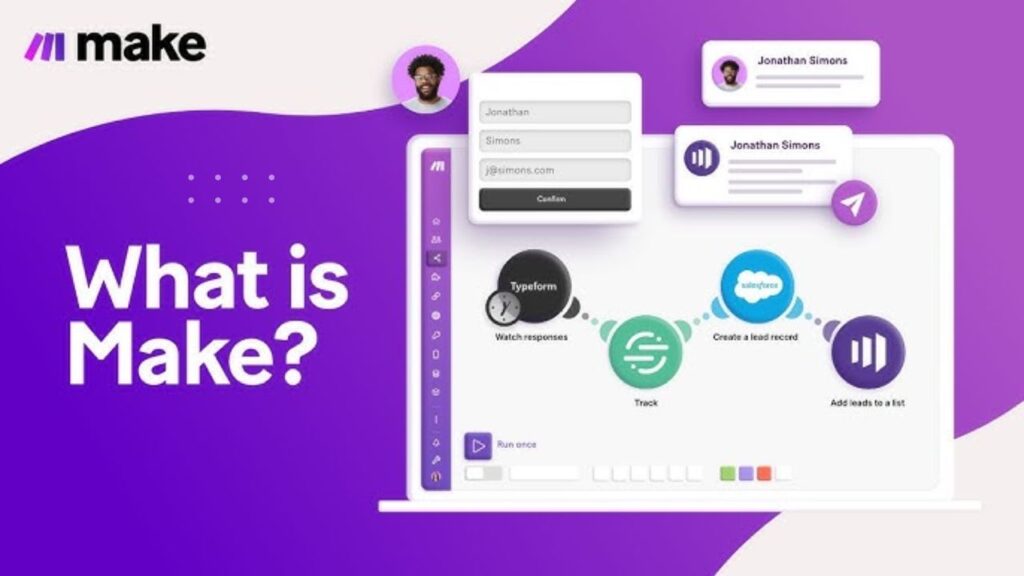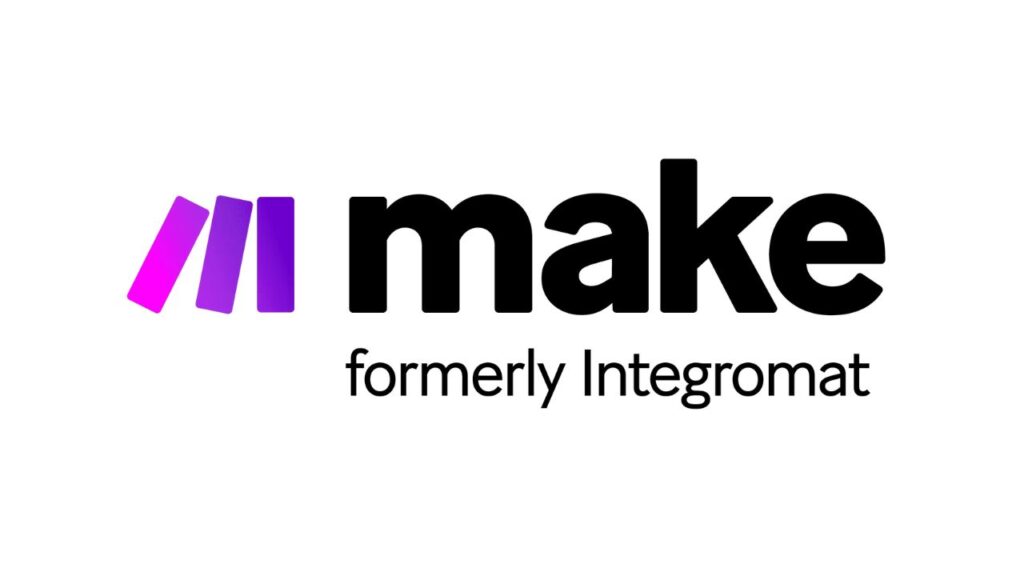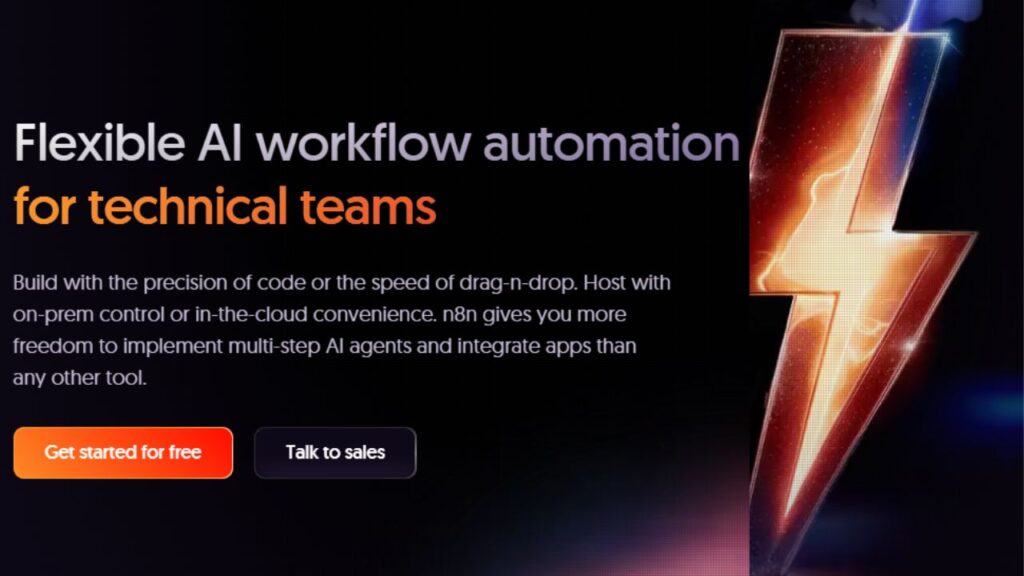In today’s fast-paced digital world, time is currency—and if you’re spending hours on repetitive tasks, you’re essentially burning cash. Enter Make.com—a no-code powerhouse that helps you automate just about anything online. Whether you’re a solo entrepreneur, marketer, developer, or enterprise team, Make.com (formerly Integromat) has become a secret weapon for saving time, boosting productivity, and scaling operations without hiring a single developer.
But what exactly is Make.com? How does it work? And more importantly, how can you use it to change the way you work forever?
Let’s break it down in this complete 2025 guide to Make.com—with real-world use cases, expert tips, and SEO-ready insights to help you master the art of automation.
What Is Make.com?
Make.com is a visual, drag-and-drop automation platform that lets users connect apps, automate workflows, and move data between systems—without writing any code.

Imagine it like a digital Lego set: you can connect blocks (apps and actions) together to build powerful automations called “scenarios”.
With over 1,500+ integrated apps (think Google Sheets, Airtable, Slack, Shopify, Notion, etc.), Make empowers individuals and businesses to create end-to-end automations—visually, intuitively, and efficiently.
Why Make.com Matters in 2025
The need for no-code and low-code tools is skyrocketing. Gartner predicts that by 2025, 70% of new apps will be built using no-code/low-code platforms.
Make.com stands at the forefront of this movement, enabling:
- Startups to automate operations with zero developers.
- Marketing teams to trigger lead nurturing emails automatically.
- eCommerce stores to update inventory in real-time across platforms.
- Agencies to scale without increasing headcount.
In short: Make.com isn’t just a tool—it’s a productivity revolution.
How Make.com Works: The Basics

Let’s say you want to automatically send a Slack message when someone fills out your Typeform. Here’s what you’d do on Make:
Step 1: Create a Scenario
This is your automation blueprint. A scenario is a series of connected modules that pass data between apps.
Step 2: Choose Your Apps
Start with Typeform (trigger), then add Slack (action). Make will guide you through API authentication.
Step 3: Set Triggers and Actions
Tell Make what should happen when a form is submitted—e.g., “Send Slack message with form responses.”
Step 4: Test and Schedule
Preview how it works. If all’s well, schedule the scenario to run in real-time, intervals, or on a custom schedule.
Voila! Your workflow is automated. And this is just scratching the surface.
Powerful Features That Set Make.com Apart
✅ Drag-and-Drop Scenario Builder
No coding, no confusion. Just connect modules visually in a flowchart-style editor.
✅ Advanced Filtering and Conditions
Add filters, routers, and conditional paths to create complex, logic-based workflows.
✅ HTTP & Webhook Support
For developers or tech-savvy users, Make offers powerful webhooks and HTTP modules to connect to virtually any API.
✅ Error Handling & Execution History
Track every step of your automation and fix issues with built-in logs and auto-retry features.
✅ Scheduling Options
Run automations on specific dates, intervals, or custom timeframes—perfect for recurring reports or batch processing.
Real-Life Use Cases for Make.com
Let’s get practical. Here are five real-world examples of how Make.com is being used in 2025:
1. Marketing Automation
Automate lead tracking from Facebook Ads to Google Sheets, notify your sales team on Slack, and trigger follow-up emails via Mailchimp.
Tools Involved: Facebook Ads, Google Sheets, Slack, Mailchimp
2. eCommerce Order Fulfillment
Send Shopify orders to Google Sheets, create shipping labels in ShipStation, and notify customers by Gmail—all automatically.
Tools Involved: Shopify, Google Sheets, ShipStation, Gmail
3. Content Creation
Convert blog drafts from Notion to WordPress, schedule posts via Buffer, and track performance in Google Analytics.
Tools Involved: Notion, WordPress, Buffer, Google Analytics
4. HR & Recruitment
Automate resume intake from Gmail, parse it with AI tools, and create Trello cards for interviews.
Tools Involved: Gmail, ChatGPT API, Trello
5. Client Onboarding
New client signs up via Typeform → Trigger welcome email → Create a new ClickUp project → Notify team in Slack.
Tools Involved: Typeform, ClickUp, Gmail, Slack
Expert Insights: Why Professionals Love Make.com
“We save at least 50 hours a month using Make to automate everything from reporting to client onboarding.”
— David B., Agency Founder
“Compared to Zapier, Make gives me more control and visibility into what’s happening behind the scenes.”
— Lydia S., Marketing Ops Manager
“The fact that I can build multi-step workflows, parse JSON, and even connect to lesser-known APIs is game-changing.”
— Rob T., SaaS Product Manager
Make.com vs Zapier: Key Differences in 2025
| Feature | Make.com | Zapier |
|---|---|---|
| Visual Builder | Yes (Flowchart Style) | No (Linear Style) |
| Pricing | More affordable for complex workflows | More expensive at scale |
| Scenario Flexibility | High (filters, routers, logic paths) | Moderate |
| Developer Options | Strong (webhooks, HTTP, JSON) | Basic to Intermediate |
| Execution Speed | Near real-time | Near real-time |
Verdict: If you want complex, customizable automation, go with Make. For simple two-step zaps, Zapier works just fine.
Make.com Pricing (As of 2025)
Make.com offers a freemium model. Here’s a breakdown of its latest pricing tiers:
Free Plan
- 1,000 operations/month
- 2 active scenarios
- Access to all core features
Core Plan ($10/month)
- 10,000 operations/month
- Advanced scheduling
- More app connections
Pro Plan ($29/month)
- 40,000 operations/month
- Priority support
- Advanced error handling
Teams & Enterprise
- Custom pricing
- SSO, custom roles, and team collaboration features
Is Make.com Secure?
Yes. Make.com uses bank-level encryption, GDPR-compliance, and role-based access controls. You can safely automate tasks involving sensitive business data.
Getting Started With Make.com: A Beginner’s Checklist
- Sign up for a free account at Make.com.
- Explore templates to find pre-built workflows.
- Choose your first automation—keep it simple.
- Use the scenario builder to customize logic.
- Test and iterate before scaling.
- Join the community forums or Discord to get support.
Learning Resources
- Make Academy: Free courses on building automations.
- YouTube Tutorials: Step-by-step walkthroughs.
- Official Help Docs: In-depth technical support.
- Communities: Reddit, Discord, and Facebook groups.
Make.com in 2025: What’s New?
- AI-Powered Automation: Make now integrates with ChatGPT, Claude, and other LLMs to enable AI-driven workflows.
- Mobile App Launch: Manage and trigger automations from your phone.
- Custom API Integrations: Drag-and-drop support for custom apps without writing backend code.
Key Benefits of Make.com Summarized
- 🔧 No-code builder with visual UI
- 🚀 Over 1,500 apps to integrate
- 🧠 Smart logic, filters, routers
- 💰 Cost-effective compared to competitors
- 🧩 Perfect for individuals, SMBs, and enterprises
- 🔁 Real-time and scheduled automation
FAQs About Make.com
Is Make.com suitable for non-tech users?
Absolutely! Its drag-and-drop interface is designed for beginners, while offering advanced tools for developers.
Can I use Make for free?
Yes, the free plan is great for starting out and testing small workflows.
Is Make better than Zapier?
If you need visual workflows and advanced automation, Make.com is often more flexible and affordable than Zapier.
Can Make handle large-scale operations?
Yes. With enterprise plans and high-operation limits, it’s built for scaling.
What’s the learning curve like?
It takes a day or two to get comfortable, but Make’s templates and tutorials speed things up significantly.
Final Thoughts: Why Make.com Is a Must-Have in Your Tech Stack
Whether you’re managing a side hustle or running an enterprise, Make.com empowers you to reclaim your time, boost productivity, and build smarter systems. Its unmatched visual builder, deep app ecosystem, and advanced features make it the go-to platform for automation in 2025.
So if you’re still doing repetitive tasks manually, it’s time to stop.
Start building. Start automating. Start making—on Make.com.




